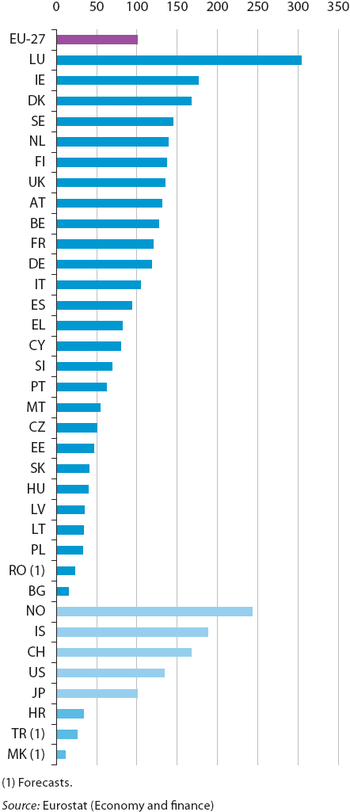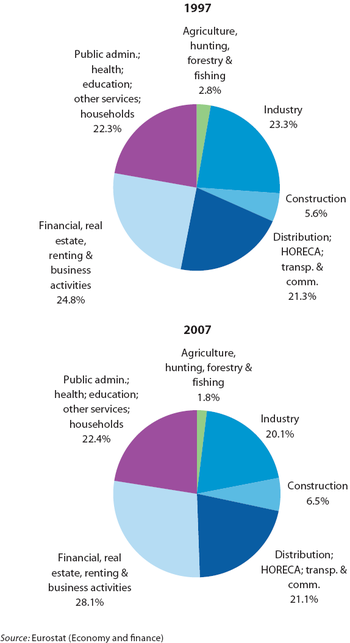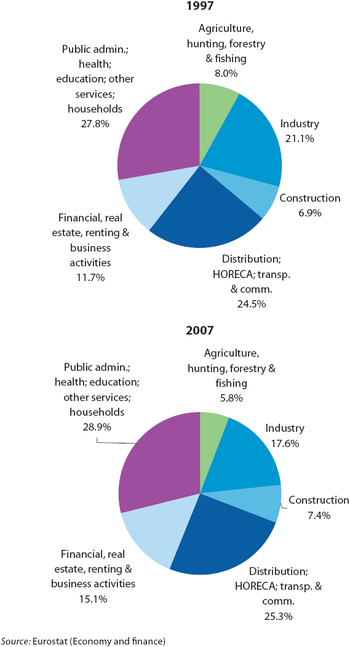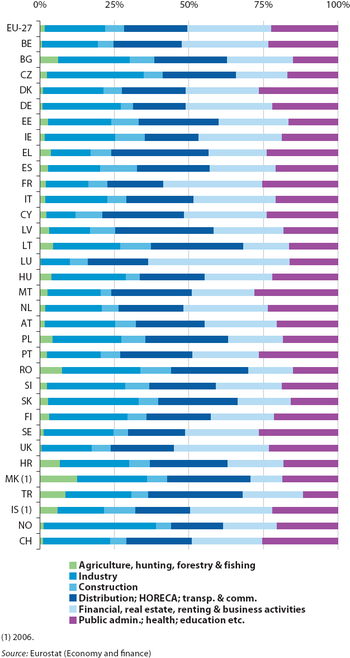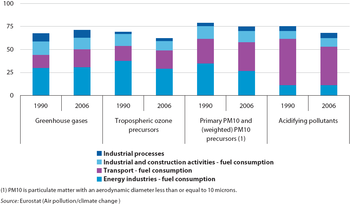- Data from January 2009, most recent data: Further Eurostat information, Main tables and Database
This article belongs to a set of statistical articles which analyse the structure, development and characteristics of the various economic activities in the European Union (EU). The present article is part of the business economy overview, and covers the macro-economic outlook of the business economy.
Main statistical findings
Gross domestic product (GDP)
The most common indicator for measuring a nation’s economic activity is gross domestic product (GDP). This indicator covers the production activity of resident producers, calculated as the sum of gross value added from all activities/industries within an economy.
It is important to consider the cyclical changes in GDP over the past decade when reading structural business statistics articles, as the evolution of output or sales in many activities follows closely the economic cycle of the whole economy. GDP growth in the EU-27 rose at a relatively fast pace during the late 1990s, with annual rates of growth peaking in 2000 at 3.9 %, after which there was a slowdown in the pace at which economic activity expanded, in particular for 2002 and 2003. The EU-27’s GDP growth thereafter accelerated with rapid expansions in 2006 (3.1 %) and 2007 (2.9 %). At the time of writing, latest forecasts for 2008 show a considerable slowdown in activity, with the rate of GDP growth almost halving between 2007 and 2008, while forecasts for 2009 from a range of international organisations point to global growth rates close to zero.
Figure 1 shows the evolution of constant price GDP (at fixed 2000 exchange rates) between 1998 and 2008 in the Triad economies of the EU-27, Japan and the United States (forecasts are included for 2008). GDP rose on average by 2.3 % per year in the EU-27 during the period concerned, which was below the rate recorded for the United States (2.8 % per year), but higher than that for Japan (1.6 % per year).
The level of GDP, per se, says little about the economic performance of a country. In order to normalise GDP, one of the most common approaches is to use GDP per capita (obtained by dividing GDP by the number of inhabitants in a country/region). This indicator is often used as a measure of living standards. For international comparisons, GDP per capita should ideally be calculated in terms of GDP per capita in purchasing power standards (PPS) [1]. Figure 2 shows that Luxembourg had by far the highest level of GDP per capita in PPS terms in 2007, at just over three times the EU-27 average, well above the next highest figures that were recorded for Ireland and Denmark (where GDP per capita was 76 % and 67 % above the EU-27 average). At the other end of the range, the 12 Member States that joined the EU in 2004 or 2007, as well as Spain, Greece and Portugal, all reported GDP per capita below the EU-27 average. The lowest standard of living (using this measure) was recorded in Romania and in Bulgaria, where this ratio was less than a quarter of the EU-27 average.
Structure of the EU economy – an overview
According to national accounts, the group of activities covered in structural business statistics sectors – hereafter referred to as the business economy (NACE Sections C to K) – accounted for 75.8 % of the total value added generated in the EU-27 in 2007 (see Figure 3). This marked an increase of 0.9 percentage points when compared with the corresponding share of a decade before.
The largest sector (in terms of value added generated) was financial, real estate, renting and business activities (NACE Sections J and K), which accounted for 28.1 % of the EU-27 total in 2007. Distribution, hotels, restaurants and catering (HORECA), communications and transport services (NACE Sections G to I) and industry (NACE Sections C to E) both accounted for slightly more than a fifth of the EU-27's economic output. Construction (NACE Section F) registered a 6.5 % share, while among those activities not covered within structural business statistics sectors, the lion's share of the remaining added value (22.4 % of the EU-27 total) was generated by public administration, health, education, other services and households (NACE Sections L to P); the outstanding 1.8 % of value added was attributed to agriculture, hunting, forestry and fishing (NACE Sections A and B).
The structure of economic output within the EU-27 has generally shifted away from traditional economic sectors such as agriculture or industry, towards services. This trend may, at least in part, be attributed to the outsourcing phenomenon, as supporting and ancillary operations which were previously done in-house are awarded to outside contractors (for example, transport services or logistics, information technology, accounting and payroll services, or industrial cleaning). International outsourcing implies that an enterprise contracts out work to external suppliers from another country, whereas off-shoring is when an enterprise maintains control/ownership of a production/service facility that moves abroad. These phenomena are examples of how structural changes may take place in the European business economy, as enterprises relocate in the face of relatively high wages and increased global trade that have driven out (in particular) price sensitive segments of the EU-27 economy to lower labour cost regions. As such, some industrial enterprises have sought to invest in production facilities in emerging economies to benefit from relatively low unit labour costs and/or to improve their chances of market entry in an untapped region. However, the process is not restricted to industrial activities, as several services have followed a similar pattern, for example, call centres, financial and computer services, or research and development activities. These changes in the way that enterprises do business may, at least in part, explain why the share of industry in EU-27 total value added declined by 3.2 percentage points between 1997 and 2007, while the largest relative gains were concentrated among financial, real estate, renting and business activities, where a 3.3 percentage point increase was registered.
Just under two thirds (65.3 %) of the EU-27's workforce were employed within the business economy in 2007 (see Figure 4); this was more than 10 percentage points lower than the corresponding share of the business economy in total value added. The difference could be largely attributed to the relatively low share of persons employed in financial, real estate, renting and business activities (15.1 % of the total workforce, compared with a 28.1 % share of total value added). In contrast, agriculture, hunting, forestry and fishing; construction; distribution, HORECA, communications and transport services; as well as public administration, health, education, other services and households were all relatively labour-intensive. Indeed, the largest employer in the EU-27 in 2007 (on the basis of national accounts data) was public administration, health, education, other services and households, accounting for almost three out of every ten persons (28.9 %). Just over a quarter (25.3 %) of the EU-27’s workforce was employed in distribution, HORECA, communications or transport services.
Structural differences between the Member States
Figure 5 shows the relative contribution of the six national accounts activity aggregates to total value added in 2007. The structural differences observed between the Member States should be borne in mind when reading the structural business statistics sectoral articles. In particular, it is important to consider the relative weight of those sectors that are not included in the structural business statistics articles, as agriculture, hunting, forestry and fishing, and more particularly, public administration, health, education, other services and households can often account for a relatively high share of economic activity. However, the relative weight of these two activities does not have a direct impact on the calculation of shares and ratios that are presented throughout the structural business statistics sectors as the non-financial business economy is often used as the denominator when creating indicators for analysis.
On average, agriculture, hunting, forestry and fishing and public administration, health, education, other services and households accounted for 24.2 % of total value added in the EU-27 in 2007. Their share of total value added peaked at 30.6 % in Malta, falling to almost half this level in Luxembourg (16.6 %). The relative importance of agriculture, hunting, forestry and fishing was particularly high in Romania and Bulgaria (7.5 % and 6.2 %), while upwards of 25 % of total value added was generated by public administration, health, education, other services and households in Malta, Denmark, Portugal, Sweden and France.
Among the activities covered by the structural business statistics sectoral articles, Luxembourg, France and the United Kingdom were all relatively specialised in financial, real estate, renting and business activities, as these activities accounted for upwards of 30 % of their total value added (rising to 47.3 % in Luxembourg). Industrial activities were particularly concentrated within central Europe, with the highest shares of industry in total value added being recorded in the Czech Republic, Slovakia, Germany, Romania and Slovenia. In contrast, the tourism-rich economies of Greece, Cyprus and Malta were joined by the Baltic States and Poland, where distribution activities accounted for a relatively high share of value added, as the Member States that displayed the highest degree of specialisation in distribution, HORECA, communications and transport services. The most specialised Member States within the construction sector were Spain (12.3 % of total value added), Romania (10.3 %) and Lithuania (10.2 %).
Figure 6 shows a similar breakdown for employment: the main difference is the striking number of persons employed within agriculture, hunting, forestry and fishing activities in Romania (2006), Bulgaria and Poland (2006), a share that rose to 30.6 % in Romania. The relative importance of public administration, health, education, other services and households was also generally higher in relation to employment when compared with value added. Indeed, as many as 39.0 % of the Swedish workforce were occupied in these activities in 2007, and upwards of one third of the total in France (2006), Denmark, Belgium and Finland.
Future challenges; information technology and climatic change
In its mid-term review of industrial policy (COM(2007) 374), the European Commission identified some key challenges facing European business, in particular, the intensified impact of globalisation and technological change, the challenges posed by climate change, and the possibilities for exploring opportunities relating to new low-energy and resource-saving processes and products.
One basic indicator to measure the take-up of information technology is the Internet penetration rate. The proportion of EU-27 enterprises having access to the Internet in 2008 was 93 %[2], while 81 % of all enterprises had a broadband connection (see Figure 8). This latter share ranged from 92 % in France, Spain and Finland, to less than two thirds of all enterprises in Bulgaria, Latvia, Poland, Lithuania and Romania (where the lowest share of 44 % was registered).
Aside from its potential for making business more productive and efficient, the Internet also offers a range of opportunities for e-commerce, both with other businesses (B2B), as well as final consumers (B2C). A relatively small proportion of enterprises (16 %) in the EU-27 received orders on-line in 2008, with this latest figure representing a gain of four percentage points in relation to 2005 (see Figure 9). The likelihood that an enterprise received orders on-line rose as a function of its average size, from 15 % for small enterprises to 33 % for large enterprises.
Some 28 % of enterprises in the EU-27 in 2008 made on-line purchases, which was also four percentage points higher than in 2005. As with sales through the Internet, the highest proportion of enterprises making purchases over the Internet was recorded among large enterprises (42 %). Note, however, that the pace at which Internet sales and purchases grew between 2005 and 2008 was fastest among small enterprises.
The EU has set ambitious environmental goals to increase energy efficiency, to reduce greenhouse gas emissions (by at least 20 % by 2020), to promote renewable energy sources, and to invest in a range of environmental industries. Figure 10 shows that there have been sizeable reductions in national emissions across the EU-27, on the basis of a comparison with 1990 – in particular for ozone precursors, particulate matter and acidifying pollutants. Figure 11 presents more detail in relation to the main sources of emissions, with fuel consumption for transport and within energy-producing industries generally accountable for the highest levels. Energy-producing industries and transport accounted for almost one third and one fifth (31 % and 19 %) of all greenhouse gas emissions in 2006. Between 1990 and 2006 there was a general trend for EU-27 emissions from energy-producing industries and from industrial and construction activities to fall (as a share of total emissions), while the share of emissions from transport tended to rise.
Data sources and availability
The main part of the analysis in this article is derived from Eurostat statistics on economy and finance, on information society, and on air pollution/climate change.
Further Eurostat information
Publications
Main tables
Database
Dedicated section
See also
- Business economy - structural profile
- Business economy - expenditure, productivity and profitability
- Business economy - enterprise demography and size class analysis
- Business economy - employment characteristics
- Business economy - evolution of production, employment and turnover
- Business economy - external trade


